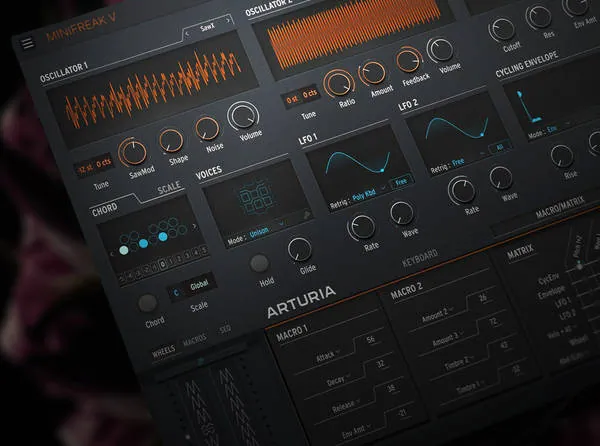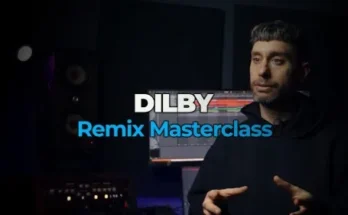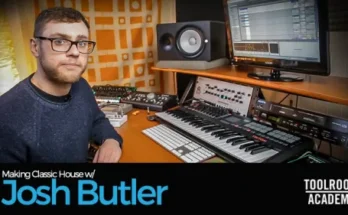Join Tyler Coffin for a detailed look at Arturia’s MiniFreak V, the softsynth version of their highly acclaimed MiniFreak hardware hybrid synth. In this MiniFreak V video course, Tyler will walk you through all the controls, parameters, and sound possibilities, leaving you in full command of this instrument’s sonic potential and ready to begin integrating it into your workflow on your very next production. These videos are for new MiniFreak V users.
After welcoming you to the course, Tyler begins with a bit of background regarding the Arturia MiniFreak and discusses the basic concept of this virtual recreation. Then you’ll get a quick tour of the interface and basic operation of the synth, so you can start making noise and having fun right away. After that, you’ll explore the Home panel, which contains the main elements of the instrument’s sound production process, including the filter, effects, and oscillator sections.
Next up, Thomas focuses on the Advanced panel, which houses even more parameters for extensive control over the sound. You’ll find the Macro/Matrix tab and LFO Shaper here, both of which allows for nearly limitless modulation possibilities, mappable in an extensive array of combinations for the ultimate experience of sonic tweaking and playability.
Throughout the remainder of the course, you’ll learn the rest of the components, including the Sequencer panel (complete with its own arpeggiator for designing rhythmically charged sequences and/or textures), preset management and browser (different methods of organization to suit your taste), and more. The course wraps up with three sound-design videos, each focusing on a different classic application: bass, lead, and pad.
Arturia’s MiniFreak V puts all the power and creative capabilities of its hardware big brother into your lap, ready for the plucking. After watching this Arturia MiniFreak V video course, you’ll be ready to hit the ground running with a complete understanding of each and every component in this brilliant emulation. Check out the descriptions of the individual MiniFreak V tutorial videos for information and inspiration. Bold new sounds await at every turn… watch “Arturia MiniFreak V Explained®” today!
What You Will Learn
– Background information on the hardware version (MiniFreak) and development of the virtual recreation
– Interface layout and basic operation for immediate hands-on experimentation
– Controls and parameters found on the Home panel, including effects, filter, and oscillator
– Additional sound-sculpting components on the Advanced tab, such the Macro/Maxtrix tab and LFO shaper
– Sequencer operation, preset/browser management, sound design examples
– And more!
Content
1. Introduction & Overview (2:19)]
First, we get a brief look at the broad aspects and nature of the Arturia MiniFreak V as well as a bit of background before digging further into this virtual recreation of Arturia’s own digital/analog hybrid synthesizer.
2. User Interface & Basic Operation (5:31)
Get acquainted with the main interface and general layout of the MiniFreak V so you’ll have a good initial idea of how we can approach it in more detail moving forward.
3. Home Panel Pt. 1 (6:03)
The Home Panel contains the elements of the MiniFreak’s audio path from signal generation to output. Here, we see the features of the Filter and Effects sections of the synthesizer.
4. Home Panel Pt. 2 (12:49)
We continue through the remainder of the Home Panel, seeing the many options we have for synthesis in the Oscillator sections.
5. Advanced Functions Pt. 1 (14:02)
Expanding upon the capabilities of the Home Panel, the Advanced Functions allow deeper control of the MiniFreak V. In this video, we open these additional controls and settings seen within it.
6. Advanced Functions Pt. 2 (6:38)
Here, we continue through the Advanced Functions to look at the Macro/Matrix tab and LFO Shaper, which allow for a semi-modular workflow by linking parameters and controls for modulation.
7. Sequencer Panel (9:24)
Explore the Sequencer Panel, in which we can enable and adjust the built-in arpeggiator and sequencer in the MiniFreak V.
8. Preset Management & Browser (4:42)
Arturia’s browser has always been an efficient organization too for presets in the MiniFreak V and beyond. In this video, we get a look how we can sort through it.
9. Sound Design Example: Bass (6:33)
Learn how to create a reasonably simple bass sound to get a taste of sound design in the MiniFreak V.
10. Sound Design Example: Lead (8:00)
Here, we take our sound design ideas a few steps further with the unique features of the MiniFreak V to create a more complex lead sound.
11. Sound Design Example: Pad (9:30)
In this video, we take things to another level by implementing many of the MiniFreak V’s strengths to create a rich digital pad sound that moves and evolves with modulation.
12. Review & Conclusion (4:25)
To close things out, we get a brief review of all that we’ve learned in the MiniFreak V plus a few closing remarks and tips so that you’re fully prepared to dig in and create your own great sounds in this exciting virtual instrument!




